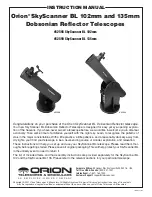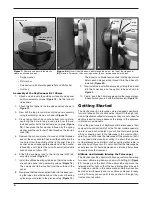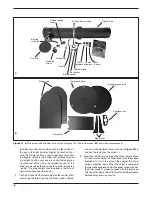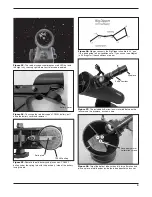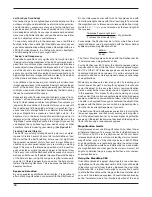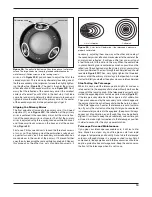
10
Let Your Eyes Dark-Adapt
Don’t expect to go from a lighted house into the darkness of the
outdoors at night and immediately see faint nebulas, galaxies,
and star clusters—or even very many stars, for that matter. Your
eyes take about 30 minutes to reach perhaps 80% of their full
dark-adapted sensitivity. As your eyes become dark-adapted,
more stars will glimmer into view and you’ll be able to see fainter
details in objects you view in your telescope.
To see what you’re doing in the darkness, use a red-filtered
flashlight rather than a white light. Red light does not spoil your
eyes’ dark adaptation like white light does. A flashlight with a red
LED light is ideal. Beware, too, that nearby porch, streetlights,
and car headlights will ruin your night vision.
“Seeing” and Transparency
Atmospheric conditions vary significantly from night to night.
“Seeing” refers to the steadiness of the Earth’s atmosphere at a
given time. In conditions of poor seeing, atmospheric turbulence
causes objects viewed through the telescope to “boil.” If you look
up at the sky and stars are twinkling noticeably, the seeing is
poor and you will be limited to viewing at lower magnifications. At
higher magnifications, images will not focus clearly. Fine details
on the planets and Moon will likely not be visible.
In conditions of good seeing, star twinkling is minimal and
images appear steady in the eyepiece. Seeing is best overhead,
worst at the horizon. Also, seeing generally gets better after
midnight, when much of the heat absorbed by the Earth during
the day has radiated off into space.
Especially important for observing faint objects is good “trans-
parency” - air free of moisture, smoke, and dust. All tend to scat-
ter light, which reduces an object’s brightness. Transparency is
judged by the magnitude of the faintest stars you can see with
the unaided eye (6th magnitude or fainter is desirable). If you
cannot see stars of magnitude 3.5 or dimmer then conditions
are poor. Magnitude is a measure of how bright a star is - the
brighter a star is, the lower its magnitude will be. A good star to
remember for this is Megrez (mag. 3.4), which is the star in the
“Big Dipper” connecting the handle to the “dipper”. If you cannot
see Megrez, then you have fog, haze, clouds, smog, or other
conditions that are hindering your viewing. (See
Figure 26
.)
Tracking Celestial Objects
The Earth is constantly rotating about its polar axis, complet-
ing one full rotation every 24 hours; this is what defines a “day”.
We do not feel the Earth rotating, but we see it at night from
the apparent movement of stars from east to west. When you
observe any astronomical object, you are watching a moving
target. This means the telescope’s position must be continu-
ously adjusted over time to keep an object in the field of view.
This is easy to do with the SkyScanner BL because of its smooth
motions on both axes. As the object moves off towards the edge
of the field of view, just lightly nudge or tug the telescope to
re-center it. Objects appear to move across the field of view
faster at higher magnifications. This is because the field of view
becomes narrower.
Eyepiece Selection
By using eyepieces of different focal lengths, it is possible to
attain many magnifications or powers with the SkyScanner
BL. Your telescope comes with two 1.25" eyepieces: one with
25mm focal length and one with 10mm focal length. To calculate
the magnification of a telescope-eyepiece combination, simply
divide the focal length of the telescope by the focal length of
the eyepiece:
Telescope Focal Length (mm)
= Magnification
Eyepiece Focal Length (mm)
For example, the SkyScanner BL 102mm, which has a focal
length of 640mm, used in combination with the 25mm Kellner
eyepiece, yields a magnification of 26x:
640mm
= 26mm
25mm
The 10mm Plossl eyepiece included with the SkyScanner BL
102mm produces a magnification of 64x.
For the SkyScanner BL 135mm, the 25mm eyepiece yields a
magnification of 44x, while the 10mm Plossl eyepiece magni-
fies 110x. Other 1.25" telescope eyepieces can be purchased
to achieve higher or lower powers. It is quite common for an
observer to own five or more eyepieces to access a wide range
of magnifications.
Whatever you choose to view, always start by inserting your
lowest-power (longest focal length) eyepiece to locate and
center the object (in this case the 25mm). Low magnification
yields a wider field of view, which shows a larger area of sky
in the eyepiece. This makes finding and centering an object
much easier. Trying to find and center objects with a high power
eyepiece, which has a narrower field of view, is like trying to find
a needle in a haystack! Once you’ve centered the object in the
eyepiece with the 25mm, you can switch to a higher magnifica-
tion (shorter focal length) eyepiece, if you wish.
The best rule of thumb with eyepiece selection is to start with a
low power eyepiece, and then work your way up in magnifica-
tion. If the object looks bet¬ter, try an even higher magnification
eyepiece. If the object looks worse, then back off the magnifica-
tion a little by using a lower-power eyepiece.
Magnification Limits
Every telescope has a useful magnification limit of about 2x per
millimeter of aperture. This comes to 204x for the SkyScanner
BL 102mm, and 270x for the SkyScanner BL 135mm. Some
telescope manufacturers will use misleading claims of excess
magnification, such as “See distant galaxies at 640X!” While
such magnifications are technically possible, the actual image
at that magnification would be an indistinct blur. Low and moder-
ate magnifications are what give the best views. A small, but
bright and detailed image is always better than a dim, unclear,
over-magnified one.
Using the MoonMap 260
Orion’s MoonMap 260 is a great observing aid to use when view-
ing the Moon with your SkyScanner BL. With it you will be able
to identify a myriad of lunar features. Because the view in the
SkyScanner BL is rotated from upright, you may find it useful
to rotate the MoonMap so the image on the map matches what
you see in the telescope eyepiece. Concentrate each evening
on the “terminator”, where the illuminated portion of the lunar
Summary of Contents for 52598
Page 15: ...15 ...

